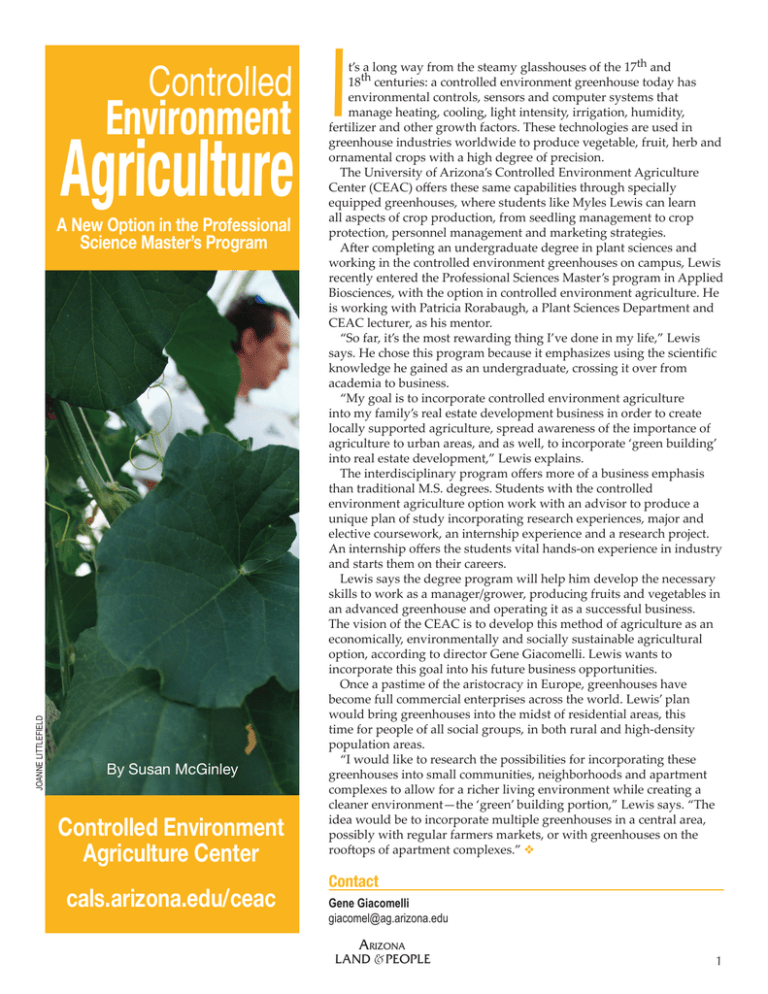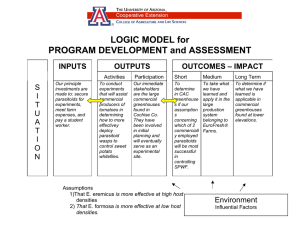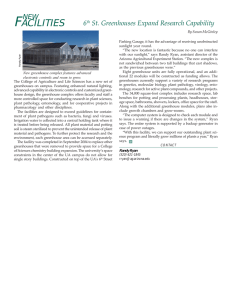I Controlled
advertisement

Controlled Environment Agriculture JOANNE LITTLEFIELD A New Option in the Professional Science Master’s Program By Susan McGinley Controlled Environment Agriculture Center cals.arizona.edu/ceac I t’s a long way from the steamy glasshouses of the 17th and 18th centuries: a controlled environment greenhouse today has environmental controls, sensors and computer systems that manage heating, cooling, light intensity, irrigation, humidity, fertilizer and other growth factors. These technologies are used in greenhouse industries worldwide to produce vegetable, fruit, herb and ornamental crops with a high degree of precision. The University of Arizona’s Controlled Environment Agriculture Center (CEAC) offers these same capabilities through specially equipped greenhouses, where students like Myles Lewis can learn all aspects of crop production, from seedling management to crop protection, personnel management and marketing strategies. After completing an undergraduate degree in plant sciences and working in the controlled environment greenhouses on campus, Lewis recently entered the Professional Sciences Master’s program in Applied Biosciences, with the option in controlled environment agriculture. He is working with Patricia Rorabaugh, a Plant Sciences Department and CEAC lecturer, as his mentor. “So far, it’s the most rewarding thing I’ve done in my life,” Lewis says. He chose this program because it emphasizes using the scientific knowledge he gained as an undergraduate, crossing it over from academia to business. “My goal is to incorporate controlled environment agriculture into my family’s real estate development business in order to create locally supported agriculture, spread awareness of the importance of agriculture to urban areas, and as well, to incorporate ‘green building’ into real estate development,” Lewis explains. The interdisciplinary program offers more of a business emphasis than traditional M.S. degrees. Students with the controlled environment agriculture option work with an advisor to produce a unique plan of study incorporating research experiences, major and elective coursework, an internship experience and a research project. An internship offers the students vital hands-on experience in industry and starts them on their careers. Lewis says the degree program will help him develop the necessary skills to work as a manager/grower, producing fruits and vegetables in an advanced greenhouse and operating it as a successful business. The vision of the CEAC is to develop this method of agriculture as an economically, environmentally and socially sustainable agricultural option, according to director Gene Giacomelli. Lewis wants to incorporate this goal into his future business opportunities. Once a pastime of the aristocracy in Europe, greenhouses have become full commercial enterprises across the world. Lewis’ plan would bring greenhouses into the midst of residential areas, this time for people of all social groups, in both rural and high-density population areas. “I would like to research the possibilities for incorporating these greenhouses into small communities, neighborhoods and apartment complexes to allow for a richer living environment while creating a cleaner environment—the ‘green’ building portion,” Lewis says. “The idea would be to incorporate multiple greenhouses in a central area, possibly with regular farmers markets, or with greenhouses on the rooftops of apartment complexes.” ❖ Contact Gene Giacomelli giacomel@ag.arizona.edu ARIZONA LAND & PEOPLE

